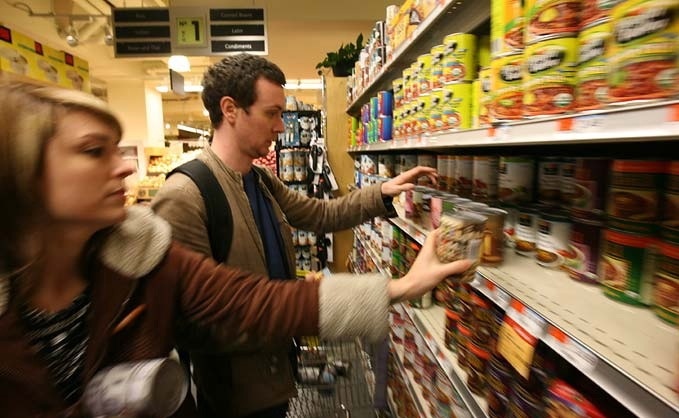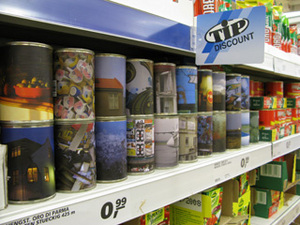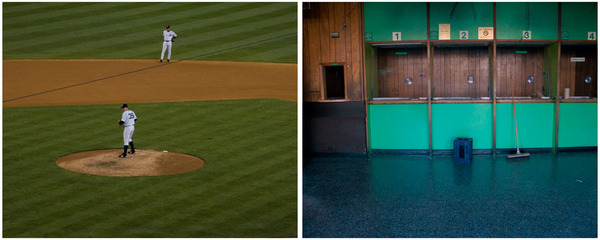This is an archive of the ArtCat Zine, 2007-2009. Please visit our new project, IDIOM.
Shopdropping and Exhibition Making: Ryan Watkins-Hughes returns to New York

I first came across the Shopdropping project in 2004 when I saw a big wall of re-configured cans stacked in perfect disarray across a wall in a big group show. Alongside were photographs of said cans in grocery stories, infusing the boring aisles with images of meat lockers, Belgian cobble stone streets, Ferris wheels and other photographs that artist Ryan Watkins-Hughes chose for each can. I eventually learned that his ongoing project is more than just adorning these cans; it's an action whose antecedents one could trace back to Situationist legacy, in line with a history of integrating art into life and creating social chaos that disturbs the inertia of an environment driven by commerce and consumption. Over the past few years, I even had the chance to to do a few "shopdrops" with Watkins-Hughes. Once in Providence, we were accused of corporate espionage, replete with threats and insults, followed by a prompt expulsion from the store. About a year ago Watkins-Hughes was profiled in the New York Times for his activities here. In April, he'll turn New York's Heist Gallery into a veritable bodega, changing the context and reception of his project, and possibly bringing it to its appropriate conclusion. -J.F.
Julie Fishkin: You've been doing the shopdropping project for quite a while now. Do you still see it as a form of social/corporate chaos?
Ryan Watkins-Hughes: I've been working on shopdropping in some form or another since 2003 or 2004? And while I'm consistently working on other projects, shopdropping seems to resonate and continue to offer new challenges to explore. My tendency is actually to be a little all over the place artistically, so it has been healthy to have one thing to come back to over the years. The key, I think, has been to keep developing the concept and to take it in new directions. The show at Heist Gallery in April will be a chance to flip the whole thing upside down. It'll be crucial to change the initial point of reference for the audience or it won't work in a gallery.
As far as creating social havoc, I'm much more interested in visual chaos and the breakdown of a "sensible" visual environment than any attempt at targeted social change. I have very little interest in creating an overt and direct critique of packaged culture and the consumer system. I'd rather create graphic mayhem within an environment that is usually so mundane. I wholly appreciate it when the unexpected, purely for its own sake, is introduced into a system that is incapable of dealing with it. It may be as simple as that. There are other "shopdropping" projects floating around that are far more politically specific, and I respect their directness, but I am more interested in fucking with the customs of visual language than in spreading a message of anti-consumerism. It's understandable to get worked up about sweat shops, mega chain stores, endless advertising, etc; but I think there are better ways to change these things than by starting an art project.

JF: You're living in New Orleans these days. That's a pretty rough place in some patches. Can you really speak about "rendering food items useless" with a clear conscience, you bourgie elitist. I'm just kidding. But seriously.
RWH: New Orleans IS a bit rough these days. But to hear New Orleanians tell it, this town has almost always been like that. The national spotlight just wasn't paying attention. I think the culture here is extremely unique, in that there is a level of freedom that doesn't exist anywhere else in the States. The other side of this, though, is that many people exploit the situation. There is an extremely high level of poverty and drug abuse here. To see that every day on a consistent basis has been an eye opener to the politics of this country over the past decade or so. People really are left to fend for themselves. New Orleans, and its neglect by the federal government since 2005, is a blatant example of this. I grew up in downtown Atlanta in the midst of its yearly competition for the title of "Murder Capital of the US," which teaches a kid a bit of street smarts, but the news here in New Orleans has been worse than anything I've seen in NY or Atlanta. This is a city with rich character and history, but it needs help. The long-time residents of the city are sick of it, and are doing what they can to stop the violence, but I think we need fundamental changes within the city, state, and national government to truly improve the situation. I don't suggest to have any idea what those changes should be, except that a solution certainly won't come in the form of a $300 stimulus check from either major political party.
As far as rendering food items useless with a clear conscience: I think food in our system has already been made pretty useless. Or at least, it has been removed from any sort of thoughtful, conscience part of our day. Most people eat what is cheap and convenient. Corn syrup and fast food. Sugars, sodium, carbs, and empty calories. When I'm busy I live off of canned food and take out. I'm sure my sodium intake right now is dangerously exceeding the recommended daily amount. I guess what I'm trying to say is that we have a surplus of food, and resources in this country to feed our citizens in a healthy and enjoyable way. But we've taken the whole ritual out of the process and many of us choose the hustle and bustle over focusing on the small things and then expect to live off of prepackaged crap.
JF: Have you done your shopdrops in New Orleans? Do you have a favorite bodega?
RWH: New Orleans is the only town I've spent a lot of time in that really rivals New York in terms of "bodega" quality. LA has some good ones, but I've only ever visited there for a bit at a time. I have a couple of favorites down here. My local one in the Irish Channel is amazing in that it is locked up tighter than Fort Knox with bullet proof windows, gates and bars. All of which might be standard procedure for a late night convenient store, but here it takes place takes at another level. Their product stock is also incredibly weird, almost like it's a front for a drug business, but it's absolutely not. It's just a family store with a tiny budget targeted towards a neighborhood with a spectrum of people from different economic situations. I'm modeling the installation at Heist on this store, but without a kitchen serving po-boys, gumbo, and Chinese food.
I haven't done any shopdrops in New Orleans yet. I have a number of them planned for early March in conjunction with a project taking place here, but the shopdropping project was largely put on hold from 2006 through all of 2007 due to a major illness. Recently, I've been working on new projects related directly to that experience. I'm still exploring the break down of complex systems and reveling in the introduction of "noise" to visual expectations. Now, it is just being thought about and presented from a far more personal prospective.
JF: How do you go from the bodega to the gallery? Isn't that sort of counter-intuitive?
RWH: I think it is a lot less counter-intuitive than the initial jump from studio to grocery store. I cringe whenever I hear of a street or graffiti artist, or someone doing another form of public intervention, say "I wanted to escape the confines of the gallery." I do this because almost everyone comes running back when a gallery finally picks up the phone and offers a show. I think as a young artist, one looks for innovative and resourceful ways to put work in front of an audience. Which is great, but I think artists have to be open to pursuing any opportunity that fits within our own terms.
I've had a few galleries and art spaces approach me over the years to offer a large-scale shopdropping show. In some way or another though, they all balked at my idea of turning their space into a fully functional corner store for a month. That's why I'm so excited to be working with Heist for this show. Talia, Molly, and the MCC crew have been on board and have understood the idea from the beginning.
JF: You miss NY? How does New Orleans compare art-wise, post-Prospect 1 and all?
RWH: I certainly miss NY. I miss living in the legitimate capital of the world. I miss being able to get amazing food from some tiny unheard-of place at 3 AM. I miss the pace, and the dedication of the people that live there. Most of all I miss New York-style friendliness. New Yorkers can be curt, but are amazingly open people once you know them personally. I don't miss the rent or the weather, at all.
Art-wise New Orleans is a mixed bag. A lot of the above-ground art here is of the pretty paintings of saxophonists variety. Or maybe a decent Ab-Ex knock off. Julia Street, which is the local Chelsea equivalent, can be pretty horrible -- but then again so is Chelsea most of the time. Once you start to dig a little though, there are really lively, tight knit communities of artists who have been making amazing work, regardless of Prospect 1. There are some great not-for profit and alternative art spaces with studio residencies and events and exhibitions. They are doing interesting things at Antenna, Mondo Bizzaro, Good Children, Barrister's, Louisiana Artworks, and the CAC (where Dan Cameron is) just to name a few. A KK Projects opening is always interesting, if not for everyone. There is also a new commercial gallery, Ammo on Royal St in the French Qt which is the center of Fleur-de-lis painting hell, that has put on consistent shows since it opened. And Mod Dance Party, for anyone that comes through town, is maybe the best monthly party I've seen in years. If you can't get down and enjoy yourself there, you're missing something inside.
JF: Will shopdropping continue or are you secretly sick to death of it?
RWH: I'm definitely more focused on other projects now, but I think it still has room to develop and improve. I've been moving more towards using it as a curatorial device over the last few years, which I enjoy. Also, I really want someone to start shopdropping the fake perfumes and handbags from Chinatown into the Fifth Avenue department stores. If you did it enough it could cause all sorts of pandemonium and a brand legitimacy panic in the public. Like a virus introduced into couture culture. I'm giving that project away, someone just email me when you pull it off so we can laugh about it together.
JF: Thanks for talking to me and see you in NOLA!! Will you treat me to a po-boy?
For sure. We'll go to Parasol's on Constance Street right up from my house. A lot of people live in houses down here. It's like an apartment but bigger.
Ryan Watkins-Hughes Bodega Project opens at Heist Gallery April 4th.
ZINE
HOME
TIPS / COMMENTS
CATEGORIES
CONTRIBUTORS
- Greg Afinogenov
- B. Blagojevic
- Adda Birnir
- Susannah Edelbaum
- Julie Fishkin
- Paddy Johnson
- Jessica Loudis
- Christopher Reiger
- Andrew Robinson
- Peter J. Russo
- Blythe Sheldon
- S.C.Squibb
- Hrag Vartanian

